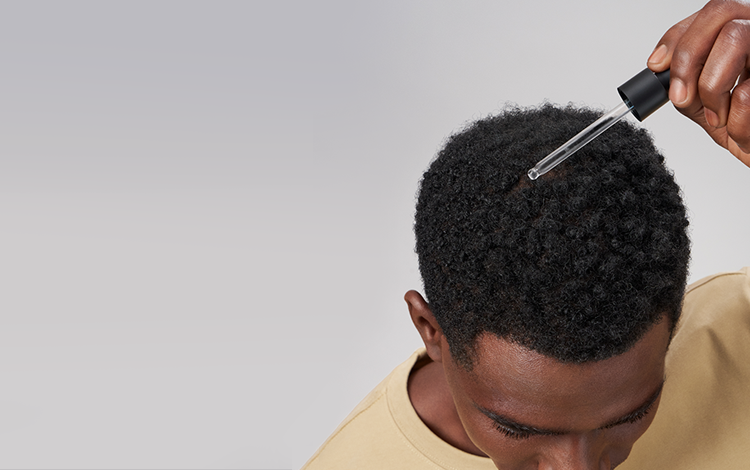Early male-pattern baldness—pattern balding that occurs before age 35—has long been considered a largely hereditary trait.
Yet, beneath the surface, a complex balance of hormones plays a key role in either sustaining or impairing hair growth. A growing body of research is challenging the oversimplified model of premature pattern balding, hypothesizing that it may instead be due to a manifestation of deeper endocrine and metabolic dysfunction described as male PCOS.[1,2]
What Is PCOS, And Why Consider a Male Equivalent?
PCOS, or polycystic ovary syndrome, is a well-documented set of endocrine-metabolic symptoms that affects around 5-10% of reproductive-age women. Women with PCOS often struggle with high androgens, irregular ovulation, a higher chance of heart issues, and insulin resistance, which can lead to weight gain.[3]
Several genes are responsible for PCOS. However, it's not as simple as hardwired genetics. Certain environmental factors can influence the genetic expression that leads to PCOS. Additionally, many women will only show a few of these symptoms, like the 20% of female cases that present lean PCOS, who experience irregular hormonal levels without insulin resistance or an abnormal BMI.[4] This is exacerbated by the fact that the mechanisms behind PCOS in females are not fully understood, and PCOS refers to a broad group of symptoms, not a single disorder. All this can complicate both treatment and diagnosis.[3]
That said, PCOS is known to run in families. While this trend has primarily been explored in the link between mother and daughters, researchers have noticed trends where brothers and fathers of PCOS patients can show similar symptoms, such as elevated androgens and metabolic disruptions.[5] Men in this group tend to display similar symptoms to PCOS, like premature hair thinning and balding, suggesting that your scalp might be revealing a more complete story about your health.[2]
Is There a Diagnostic Framework For Male PCOS?
While there's no official consensus on a set of diagnostic criteria for male PCOS, using female PCOS as a reference point, some researchers have proposed several frameworks to identify the male phenotype. These generally require a combination of clinical signs, biochemical markers, and often family history. This is an outline of proposed symptoms for a male PCOS-equivalent (for men <35 years old):
- Hormonal abnormalities: Elevated levels of DHEAS, an imbalanced LH:FSH ratio, and low sex hormone–binding globulin (SHBG).[6,7]
- Clinical signs of hyperandrogenism: Early-onset androgenetic alopecia (AGA), acne resistant to conventional treatment, and abnormal growth of terminal hairs.[1]
- Metabolic disturbances: Presence of insulin resistance or its surrogates, low SHBG, impaired glucose tolerance, dyslipidemia, or even just a trend toward weight gain. These factors indicate the same metabolic syndrome background as in PCOS.[5,6]
- Family history: A first-degree female relative with diagnosed PCOS (mother or sister) strengthens the case that a man’s symptoms are part of the familial PCOS spectrum. Many authors include positive family history as a supporting criterion for male PCOS.[5]
Men who fulfill all or most of the above would represent strong candidates for a male PCOS-equivalent diagnosis. In practice, researchers have used simpler operational definitions in studies.
For example, some researchers have defined a subset of balding men as “suspected male PCOS” if they had at least one of the following: BMI >25, HOMA-IR >2.5, or SHBG <25 nmol/L.[8] Men meeting this threshold showed the distinctive hormonal profile (higher insulin and LH, lower testosterone, etc.) and were predicted to be at greater risk of later gonadal dysfunction. This practical approach echoes how in women, PCOS is diagnosed by meeting 2 of 3 criteria (hyperandrogenism, ovulatory dysfunction, polycystic ovaries).
Notably, some experts argue that premature balding alone is too nonspecific to serve as a diagnostic marker, due to its high frequency in the general male population.[5]
What Is The Connection Between Male PCOS And Premature Pattern Balding?
The proposed connection in pathophysiology between male PCOS and early-onset androgenetic alopecia (AGA) is driven by 2 key mechanisms: hyperandrogenism and insulin resistance.
How Does Androgen Balance Influence Hair Loss?
Mechanistically, elevated androgens, like DHT, are direct drivers of pattern hair loss. DHT, the active form of testosterone, binds to androgen receptors in the scalp and causes hair follicles to shrink. Men within the proposed framework of PCOS experience an overproduction of adrenal androgens like DHEAS, leading to an increased total androgen burden.[7,9]
Does Insulin Resistance Worsen Hair Loss?
The insulin resistance that affects many women with PCOS is caused by their cells becoming less responsive to insulin, leading to elevated insulin levels. In both men and women, higher levels of insulin can impair the production of other hormones in the liver, such as sex hormone-binding globulin (SHBG).[10]
SHBG affects the availability of hormones, like testosterone and estrogen, by binding to them and keeping them in an inactive state as they circulate through the bloodstream.[11] Lower SHBG levels result in more freely circulating hormones, such as DHT, which can lead to systemic health changes and accelerate the process of follicular miniaturization and hair thinning.[12] This process mirrors the hormonal imbalance seen in women with PCOS, where hormonal imbalances cause issues like acne and excessive hair growth.
Can You Tell If Your Hair Loss Is Related To Male PCOS?
It’s important to acknowledge that pattern balding is a polygenic condition with multiple genes responsible for the observed symptoms. And, for most men, it’s a part of the normal aging process. The concept of “male PCOS” identifies a potential subset of men wherein pattern balding, hyperandrogenism, and insulin resistance coincide. In these individuals, treating underlying issues could theoretically slow hair loss or at least mitigate future health risks. Clearly, more longitudinal research is needed to determine the efficacy of male PCOS as a diagnostic model and its full connection to premature hair loss.
Since this is a medical condition, if you are experiencing premature hair loss, we recommend you discuss any concerns you may have with your doctor.
Can OS-01 HAIR Help Slow Pattern Balding?
Slowing premature pattern balding can seem like a losing battle. Chances are you've already heard of treatments like finasteride and dutasteride—both DHT blockers designed to prevent the conversion of testosterone into DHT. While these medications can work wonders for some, they're not always the perfect solution and may sometimes require additional support to treat or slow pattern balding.[13]
Interestingly, new research has connected the expression of androgens and premature cellular senescence in cells responsible for hair growth.[14] Additionally, balding cells have been shown to express higher levels of premature senescence.[15] This indicates that senescence may be a contributing factor in premature balding.[14]
That's where OS-01 HAIR comes in. OS-01 HAIR targets the cellular mechanisms that lead to hair follicle miniaturization, like oxidative stress, scalp microbiome dysbiosis, and cellular senescence. During clinical testing, participants using OS-01 HAIR saw promising results:
- 69% of participants experienced an average increase in anagen hairs of 42% after 6 months.[16]
-
81% of participants experienced an average increase in hair density of +40% after 6 months.[16]
While OS-01 HAIR is not designed to treat male pattern balding, it may help slow hair loss by protecting your hair follicles from the secondary damage caused by androgens in your scalp.
Key Takeaways
- Researchers are hypothesizing that premature balding in men may be linked to a condition similar to female PCOS.
- Male PCOS remains hypothetical, but proposed symptoms include increased androgen levels and insulin resistance, which can affect hair health.
- Just as PCOS in women tends to run in families, men with female relatives diagnosed with PCOS may be predisposed to developing male PCOS-like symptoms.
- By protecting your hair follicles from the effects of a high androgen environment, like oxidative stress and cellular senescence, OS-01 HAIR may help slow hair loss in men with pattern balding.
References
- https://onlinelibrary.wiley.com/doi/10.1155/2020/1942126
- https://pmc.ncbi.nlm.nih.gov/articles/PMC7382675/
- https://pmc.ncbi.nlm.nih.gov/articles/PMC9964744/
- https://pmc.ncbi.nlm.nih.gov/articles/PMC6405408/
- https://karolinum.cz/data/clanek/9187/PMR_122_2_0073.pdf
- https://www.nature.com/articles/s41598-017-08528-3
- https://pubmed.ncbi.nlm.nih.gov/27304785/
- https://www.endocrine-abstracts.org/ea/0049/ea0049ep1163
- https://www.ncbi.nlm.nih.gov/books/NBK430924/
- https://pmc.ncbi.nlm.nih.gov/articles/PMC2992779/
- https://pmc.ncbi.nlm.nih.gov/articles/PMC4480437/
- https://pubmed.ncbi.nlm.nih.gov/21511365/
- https://www.ncbi.nlm.nih.gov/books/NBK555930/
- https://pmc.ncbi.nlm.nih.gov/articles/PMC3828374/
- https://www.jidonline.org/article/S0022-202X(15)33852-5/fulltext
- Based on data from clinical studies and/or lab studies conducted on human skin samples, 3D skin models, and skin or hair cells in the OneSkin lab. Explore more at oneskin.co/claims





